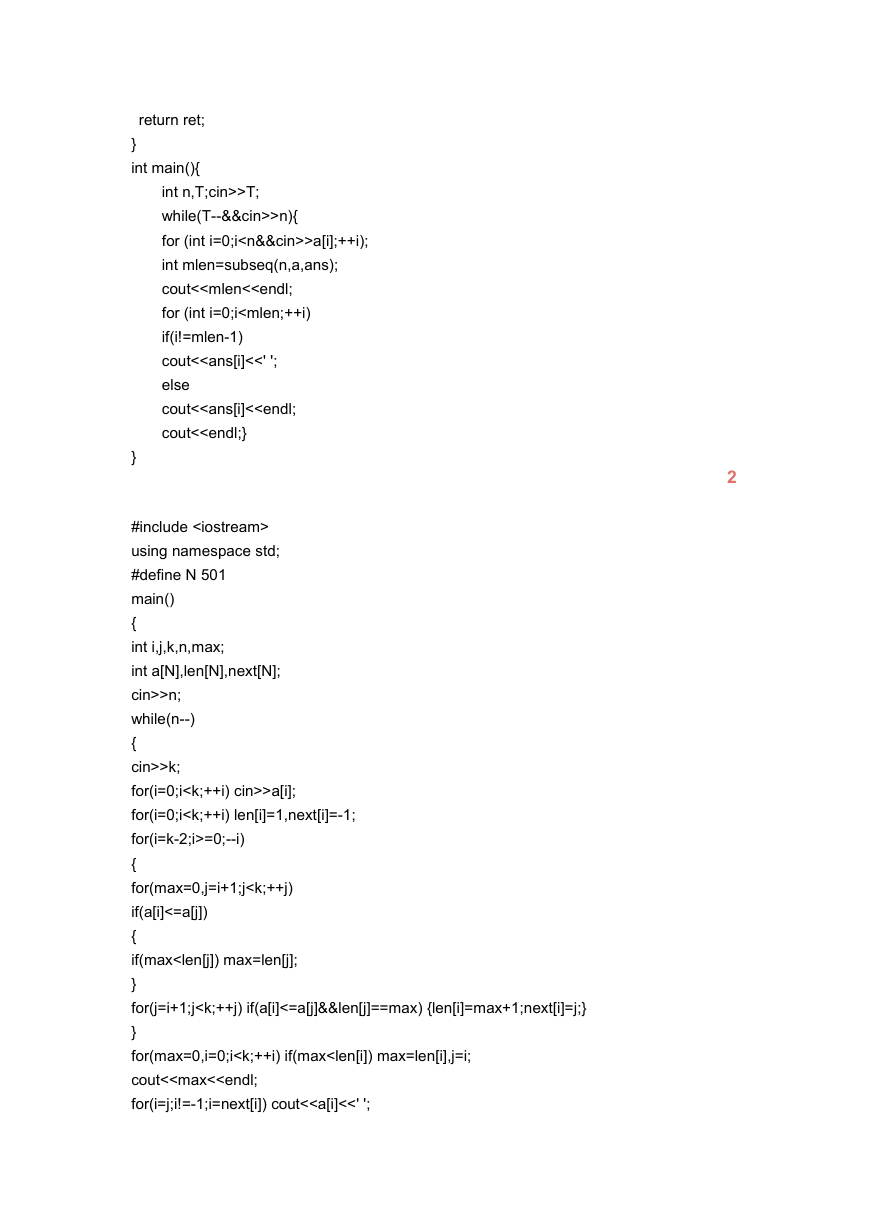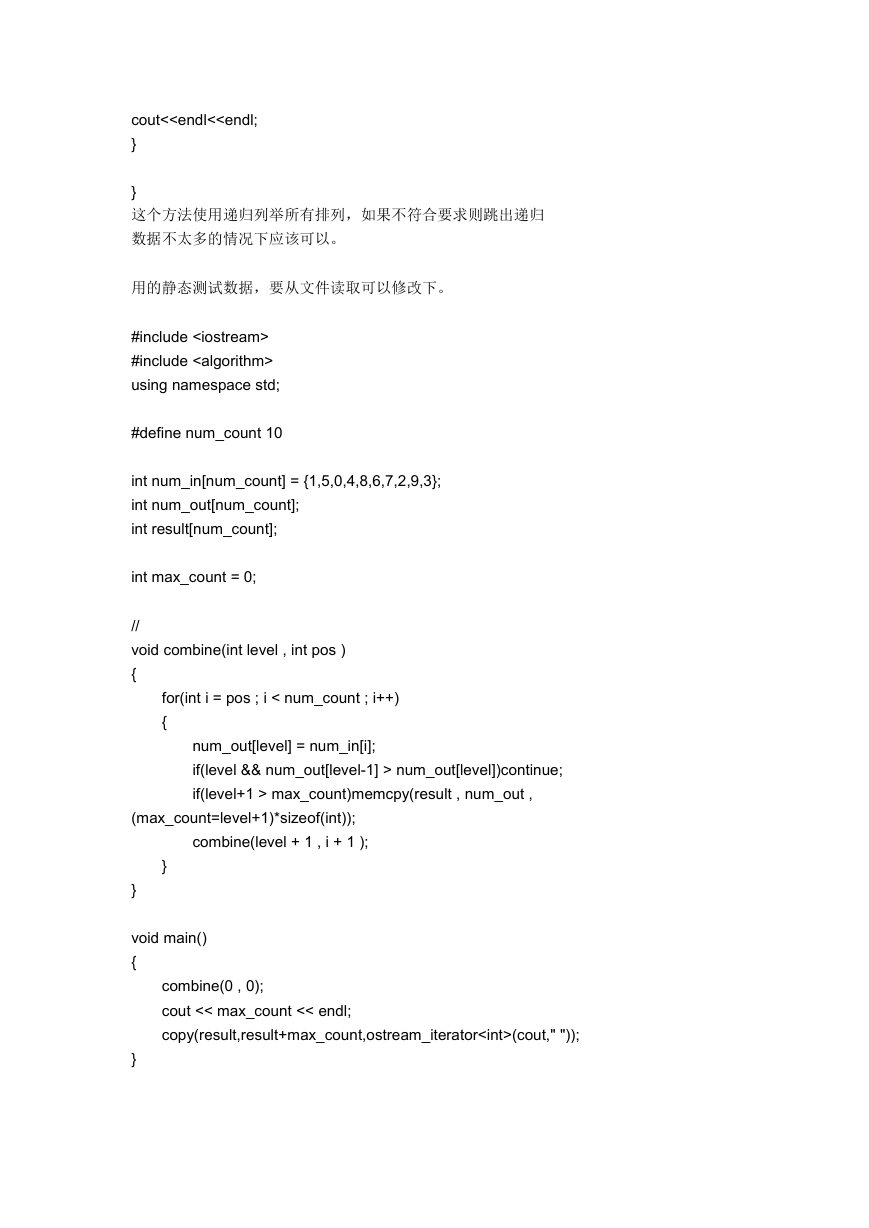求一个整数序列的最长递增子序列。
输入的第一行是一个正整数 n,表示测试例个数。接下来几行是 n 个测试例的数据,每个测
试例的数据由两行组成,其中第一行为一个正整数 k (k<=500),表示整数序列的长度,第二
行给出整数序列,整数之间用一个空格隔开。(设给出的每个整数序列的最长递增子序列都
是唯一的.对于每个测试例输出两行,第一行为最长递增子序列的长度,第二行为最长递增
子序列,整数之间用一个空格隔开。两个测试例的输出数据之间用一个空行隔开。
例如
输入:
2
5
3 1 4 2 3
6
1 3 9 5 2 6
输出:
3
1 2 3
4
1 3 5 6
提问者: 蝶破焰澈 - 三 级
最佳答案
经典的 LIS 问题.
但从算法实现角度来看是不难的,可以有较简单的 DP,O(n^2)
但数据量一大,TLE 是必然的.
辅之以二分,可以优化至 O(nlogn);
当然从你题目上可以看出,简单形式的也是可以胜任的.
下面这个是 O(nlogn);
不懂可以再问,不过实践上你可以向任何一个 ACMer 或中学生 OI 选手请教.
#include
using namespace std;
#define _cp(a,b) ((a)<(b))
int ans[501],a[501];
int subseq(int n,int* a,int* ans){
int b[501],p[501],i,l,r,m,ret=0;
for (i=0;iret))
for (m=((l=1)+(r=ret))>>1;l<=r;m=(l+r)>>1)
if (_cp(a[b[m]],a[i]))
l=m+1;
else
r=m-1;
for (m=b[i=ret];i;ans[--i]=a[m],m=p[m]);
�
2
return ret;
}
int main(){
int n,T;cin>>T;
while(T--&&cin>>n){
for (int i=0;i
>a[i];++i);
int mlen=subseq(n,a,ans);
cout<
using namespace std;
#define N 501
main()
{
int i,j,k,n,max;
int a[N],len[N],next[N];
cin>>n;
while(n--)
{
cin>>k;
for(i=0;i>a[i];
for(i=0;i=0;--i)
{
for(max=0,j=i+1;jcout<
#include
using namespace std;
#define num_count 10
int num_in[num_count] = {1,5,0,4,8,6,7,2,9,3};
int num_out[num_count];
int result[num_count];
int max_count = 0;
//
void combine(int level , int pos )
{
for(int i = pos ; i < num_count ; i++)
{
num_out[level] = num_in[i];
if(level && num_out[level-1] > num_out[level])continue;
if(level+1 > max_count)memcpy(result , num_out ,
(max_count=level+1)*sizeof(int));
combine(level + 1 , i + 1 );
}
}
void main()
{
combine(0 , 0);
cout << max_count << endl;
copy(result,result+max_count,ostream_iterator(cout," "));
}
�





 2023年江西萍乡中考道德与法治真题及答案.doc
2023年江西萍乡中考道德与法治真题及答案.doc 2012年重庆南川中考生物真题及答案.doc
2012年重庆南川中考生物真题及答案.doc 2013年江西师范大学地理学综合及文艺理论基础考研真题.doc
2013年江西师范大学地理学综合及文艺理论基础考研真题.doc 2020年四川甘孜小升初语文真题及答案I卷.doc
2020年四川甘孜小升初语文真题及答案I卷.doc 2020年注册岩土工程师专业基础考试真题及答案.doc
2020年注册岩土工程师专业基础考试真题及答案.doc 2023-2024学年福建省厦门市九年级上学期数学月考试题及答案.doc
2023-2024学年福建省厦门市九年级上学期数学月考试题及答案.doc 2021-2022学年辽宁省沈阳市大东区九年级上学期语文期末试题及答案.doc
2021-2022学年辽宁省沈阳市大东区九年级上学期语文期末试题及答案.doc 2022-2023学年北京东城区初三第一学期物理期末试卷及答案.doc
2022-2023学年北京东城区初三第一学期物理期末试卷及答案.doc 2018上半年江西教师资格初中地理学科知识与教学能力真题及答案.doc
2018上半年江西教师资格初中地理学科知识与教学能力真题及答案.doc 2012年河北国家公务员申论考试真题及答案-省级.doc
2012年河北国家公务员申论考试真题及答案-省级.doc 2020-2021学年江苏省扬州市江都区邵樊片九年级上学期数学第一次质量检测试题及答案.doc
2020-2021学年江苏省扬州市江都区邵樊片九年级上学期数学第一次质量检测试题及答案.doc 2022下半年黑龙江教师资格证中学综合素质真题及答案.doc
2022下半年黑龙江教师资格证中学综合素质真题及答案.doc